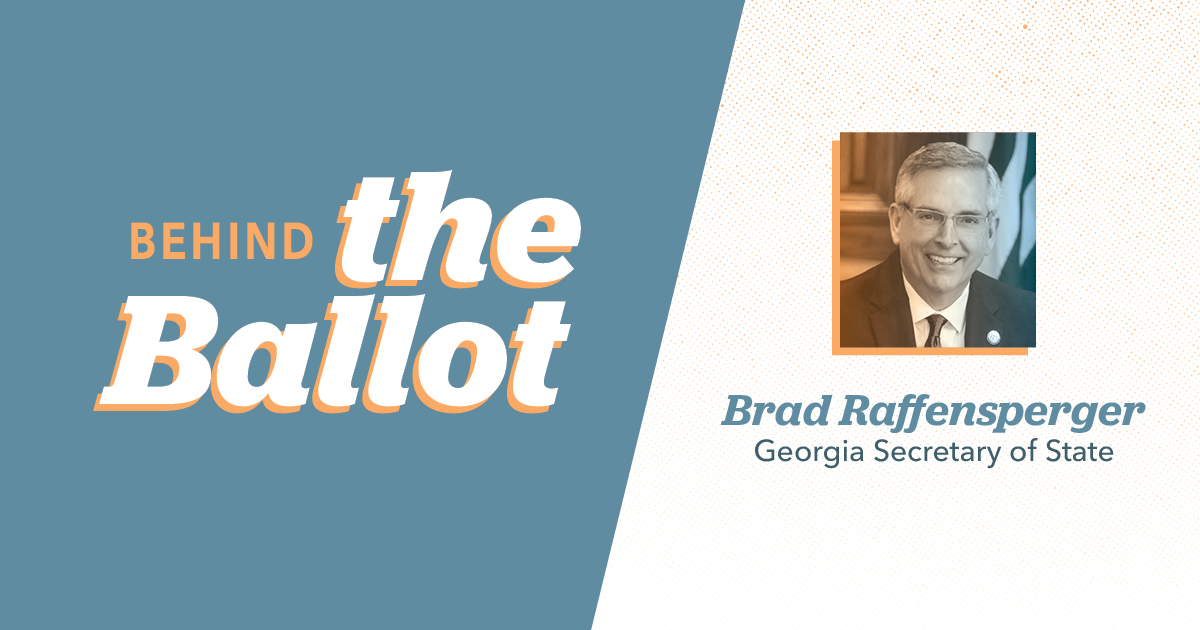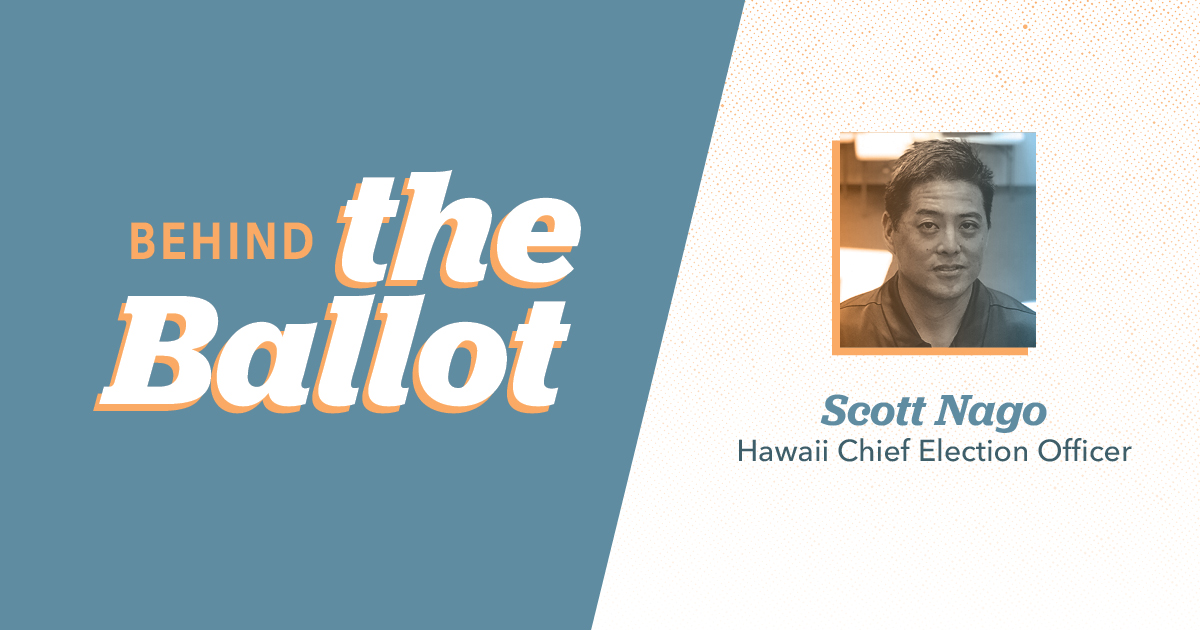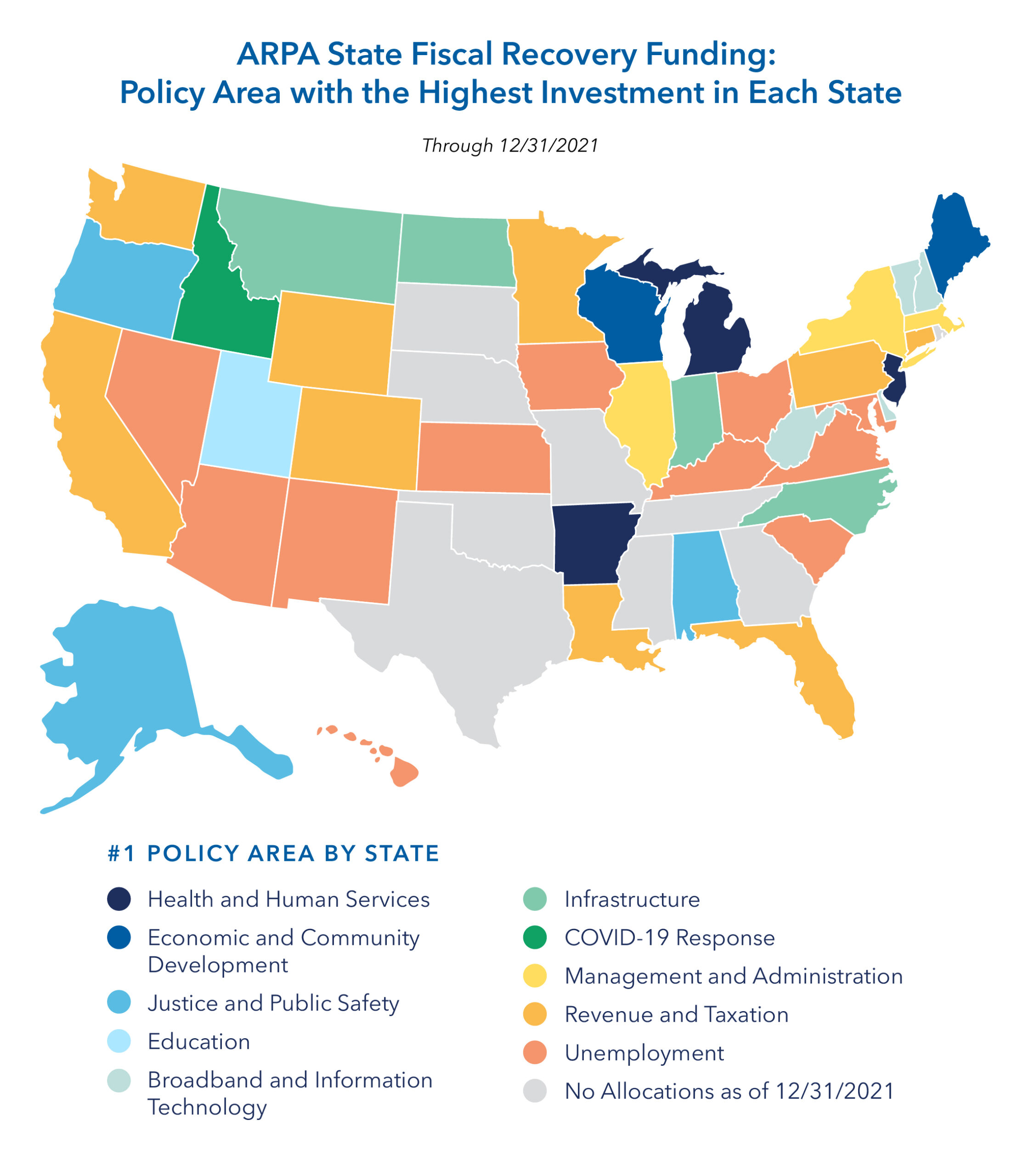The Council of State Governments Center of Innovation, in coordination with CSG South, developed a policy brief to explore the issues immigrants experience obtaining professional licensure
Continue readingThe Farm Bill: What Will 2023 Bring?
A package of federal legislation known as the Farm Bill — the most impactful piece of legislation related to agriculture — is proposed, debated and passed by Congress and signed into law by the president.
Continue readingThe Long-Term Budget Outlook: Implications for State Fiscal Policy
By Valerie Newberg
The Congressional Budget Office released its annual Long-Term Budget Outlook in July. The Long-Term Budget Outlook is a 30-year projection of different economic factors like government spending and revenues. The outlook is used as a tool for policymakers to evaluate the impact of proposed legislation against baseline economic data, such as the gross domestic product (GDP), which measures the total output of the United States economy and provides insight into to economic growth. This year’s report represents a continuation of recent forecasts, predicting a rise in mandatory federal spending on entitlement programs such as Medicare and Medicaid, increased interest costs on the deficit and a historically high debt to GDP ratio. Regardless of how the federal government approaches the unprecedented conditions predicted, states will have to grapple with changes in funding and fiscal practices to ensure their budgets remain balanced.
Here are three takeaways for state leaders from this year’s report:
- The economy remains volatile, showing signs of slowing.
There are four main projections calculated in the outlook: the deficit, debt, spending and revenues. While states are trying to predict the forecast and how to prepare, all four factors point to stormy weather and rainy days with potential long-term economic difficulties:
- Under current fiscal practices, the budget deficit is expected to climb from 2.3% of the GDP to 3.9% at the end of 2052.
- As the deficit continues to grow, the national debt will climb from its projected 2022 total of 98% of the GDP to 185% in 2052, nearly doubling in size and reaching a historic high in 2031.
- Even as the end of federal pandemic relief programs results in a dip in federal spending, the budget will ultimately rise from 23.5% to 30.2% of the GDP by 2052. Increases in spending are driven by mandatory expenditures for programs like Medicare and Social Security, which will gain more dependents and experience higher costs as the U.S. population ages. Additionally, interest on the deficit will contribute to historically high spending.
- Finally, revenues are projected to spike in 2025 as a result of the expiration of the Tax Cuts and Jobs Act of 2017. The CBO’s analysis makes clear the opportunities and feasibility of reducing the deficit through expenditure and tax-based policies and lays out the growing consequences of inaction. But until changes are made, federal spending will continue to outpace revenues.
While these projections are focused on national trends and policies, states will not be immune to the effects of economic changes; state policymakers can expect economic uncertainty to impact both federal grants to states and the circumstances around state revenue collection.
- Tax changes in 2025 are expected to temporarily increase federal revenues and will continue to impact state budgets and tax codes.
Scheduled changes to the tax code will have an impact on the national economy and state policies, but this impact will vary across states and income groups. The 2017 Tax Cuts and Jobs Act had disparate effects on state budgets and tax codes, with many states electing to align their tax laws with most or all of the federal tax legislation. Key provisions of the Tax Cuts and Jobs Act that lower taxes for individuals and families are set to automatically expire in 2025, including the expanded Child Tax Credit and the State and Local Tax Deduction. The State and Local Tax Deduction impacts high-income taxpayers in states such as California, New Jersey and New York most aggressively because the $10,000 cap on deductions generally prevents those who pay the most in state and local taxes from deducting their entire liability from their federal taxes. Lawmakers in such states have sought solutions to ease this burden and prevent the loss of high-income residents.
The future of these provisions is unclear, but the Congressional Budget Office’s analysis of the tax plan shows a nearly $1.5 trillion increase in the deficit over the next 10 years. As such, federal policymakers may look to more wide-sweeping changes to tax codes that would further impact state policies.
- Congress may look to cut discretionary spending for state grants and other projects to decrease outlays.
The Congressional Budget Office predicts that continued levels of discretionary spending between an average of 6.2% and 7% of the GDP will contribute substantially to federal debt levels. This debt, held by the public, leaves the economy at an increased risk of experiencing a fiscal crisis that would disrupt global financial stability. With adjustments in the largest mandatory spending programs such as Medicare and Social Security requiring a 60-person majority to pass the Senate and 74 percent of Americans saying benefits should not be reduced, it is more likely that funding for discretionary spending programs and grants to states would be reduced to contain expenditure levels.
Since the federal government provides an average of one-third of state revenues, states are especially vulnerable to disruptions due to changes in federal discretionary spending for programs like Special Supplemental Nutrition Program for Women, Infants, and Children (WIC), Head Start, the Low Income Home Energy Assistance Program (LIHEAP), law enforcement training and development assistance, and the Community Block Development Grant. States rely on these programs to provide for their most vulnerable citizens and policymakers will need to remain informed of their options for sustaining them when faced with reductions in federal funding.
With President Biden signing into law the Inflation Reduction Act, which will reduce the deficit by over $300 million, fiscal consolidation through reduced spending and increased taxes is clearly a top priority for lawmakers in Washington. States should expect to see further action taken, and by remaining educated on the impacts of the federal budget and the CBO’s Long-Term Budget Outlook on their states’ circumstances, leaders can prepare to effectively tackle the economic issues that impact the everyday lives of their constituents.
Behind the Ballot with Sec. Raffensperger
Brad Raffensperger – Georgia’s Secretary of State
Brad Raffensperger may have a high profile in the national media, but the Georgia secretary of state’s focus is the same as when he took office in 2018 — keeping elections secure, accessible and fair in his home state.
He couldn’t have anticipated when he started this job how quickly challenges would come, both from the right and the left.
“When I ran in 2018, I didn’t realize that, as soon as I took office, I’d have nine lawsuits from the losing gubernatorial candidate and her allies,” Raffesnperger said. “We’ve been pushing back on false election claims, really, since January of 2019.”
When he ran, Raffensperger says the issues were straightforward — Georgia was still using outdated direct recording electronic voting machines. His campaign message was based on security: the state needed to move to new voting machines with a verifiable paper ballot, and Raffesnperger wanted the authority to join the electronic registration information center, known as ERIC, a collaborative tool that allows states to objectively and accurately update voter rolls.
As it turned out, however, Raffesnperger encountered an elections climate that was far from ordinary.
“We didn’t expect it — I don’t think anyone could have expected it, really — looking at the scrutiny that [secretaries of state] have gone through since the recent elections,” he said.
Raffensperger says tensions around elections aren’t new. In Georgia, the problem goes back at least to 2014, and he lays blame to activist groups like the New Georgia Project, and to those who refused to accept the results of the 2016 election, as well. In 2020, Raffensperger didn’t hesitate to call out his own side of the aisle when former President Donald Trump made unfounded claims about fraud in the 2020 election.
“The challenge the President had is that we looked up and down the line to make sure that we checked out every single allegation,” Raffensperger said. “By the time we had that call with the President, we knew that the numbers were the numbers. And it was just trying to respectfully and as calmly, you know, let the President know that. ‘These are what the numbers are, sir.’”
False claims about elections — from the right or the left — are distractions. The important thing, Raffesnperger says, are that elections in Georgia are more secure and more accessible than ever before. The state has photo ID for all forms of voting, automatic voter registration and citizenship checks through the Department of Driver Services, and 17 days of mandatory early voting. Raffensperger says registration rates shot up, and today the state has more than 7.5 million voters.
“It just shows you that it’s easier to vote in Georgia, but we’ve struck that proper balance. Georgia is really doing a great job and we’re going to focus in on that.”
Raffensperger says trust and consensus building are two of the ways state leaders and everyday citizens can move away from election conflict and begin restoring trust in democratic institutions.
“Someone said that Eisenhower was a very effective president because he looked at where he could get 60-80% of people agreeing on an issue, and then he focused on that,” Raffensperger said. “He didn’t worry about the stuff where he knew he was going to get 20-40% or even 55%.”
Raffesnperger believes that change really begins on the individual level, though. Rather than focusing on policies, he says focusing on principles and character will create pathways back from the precipice. That, and a little bit of good will.
“Luke Bryan said it best — most people are good,” Raffensperger said. “So never lose sight of that: that most Americans are good people.”
Behind the Ballot with Scott Nago
How States are Putting American Rescue Plan Dollars to Work
By Rachel Dietert and Ben Reynolds
The American Rescue Plan Act of 2021 includes $350 billion in new funding for state, local, territorial and tribal governments through the Coronavirus State and Local Fiscal Recovery Fund. Within that fund, $195 billion is distributed to state governments and Washington, D.C. While there are some restrictions on the use of funds, states have considerable discretion. CSG has collected allocation data from state actions, enacted legislation and mandatory State Recovery Plan Performance Reports. The Council of State Governments ARPA Utilization Database includes information on these allocations through December of 2021. Data is organized into 27 “policy areas” based on funding categories. Further subcategories are provided to include more detail on the funding.
CSG is producing a series of articles focused on how states are using the State Fiscal Recovery Fund. The first article can be found here.
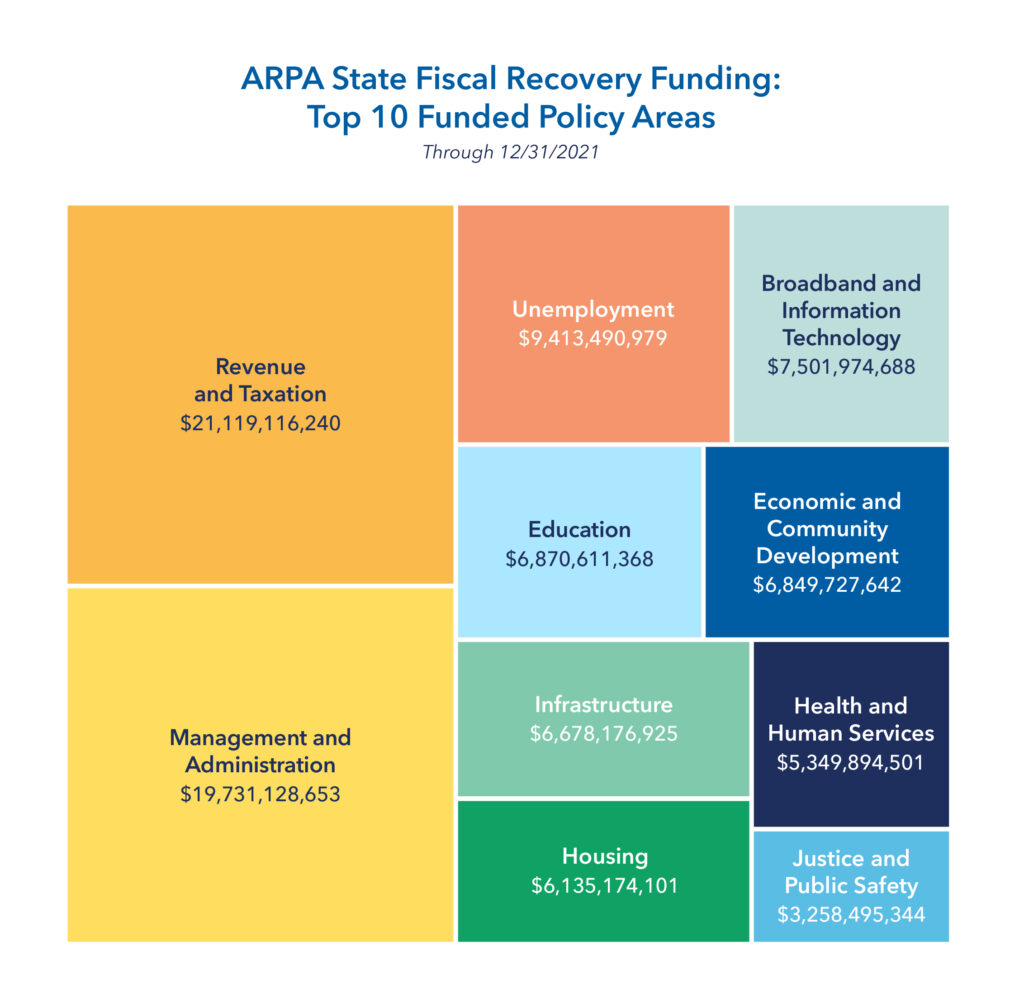
Revenue and Taxation ($21.1 billion) and Management and Administration ($19.7 billion) are the top two policy areas across the country, receiving substantially more funding than others. Revenue and Taxation was the top policy area as states elected to use funds to replace revenue lost because of the pandemic. Revenue replacement has helped states address a decrease in state tax revenue, which from April through June 2020 fell 25% compared to the same quarter of 2019 (Pew). Management and Administration investments are another way states are addressing the impacts of the pandemic. Examples of administration costs include efforts to ensure program sustainability by increasing staff or contracting with consultants.
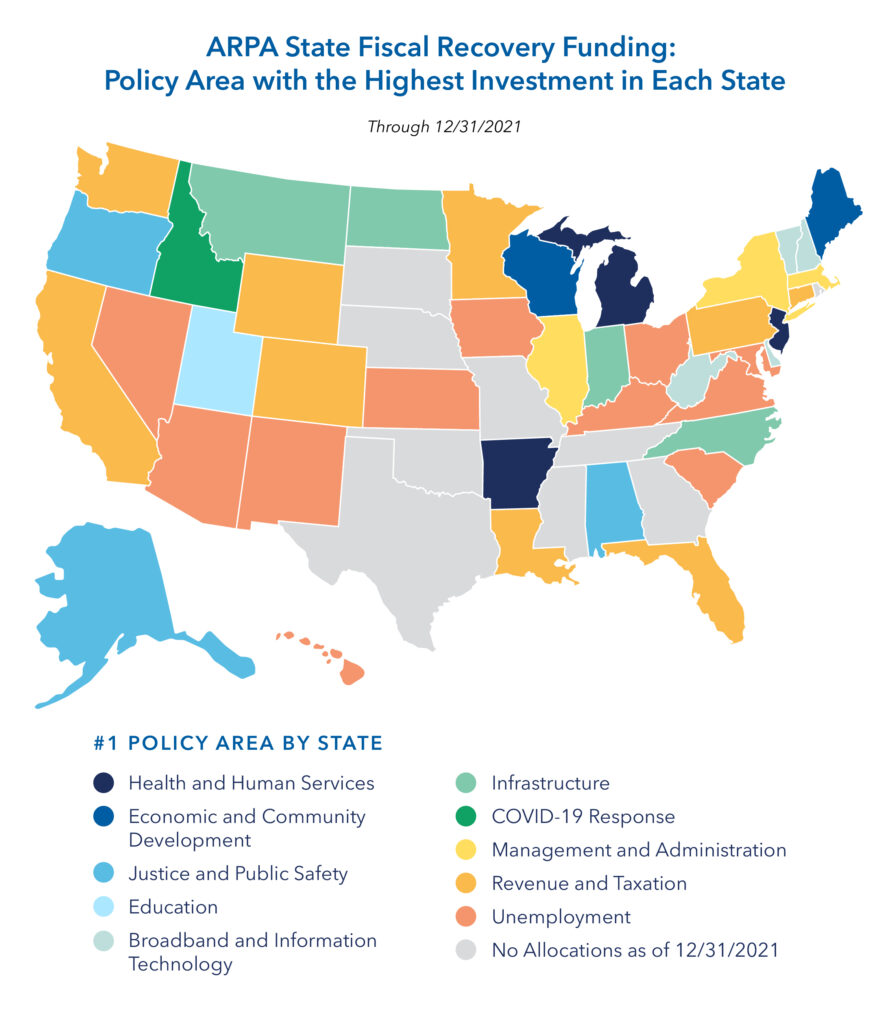
Eleven states allocated the most funding toward Unemployment. Many states made substantial deposits into unemployment insurance funds. Arizona, for example, allocated $758.8 million into its Unemployment Insurance Trust Fund.
Revenue and Taxation was the second most funded policy area. Most states used their funding toward revenue replacement. California transferred $9.2 billion to address its revenue loss due to the pandemic.
The top policy area in four states was Broadband, and another four states top policy area was Infrastructure. New Hampshire allocated $659,734 to fund its Broadband Connectivity Program while North Dakota is using $150 million to fund natural gas pipeline infrastructure grants to develop a high-pressure transmission pipeline to transport natural gas to eastern North Dakota.
Alaska, Alabama, and Oregon invested heavily in Justice and Public Safety, more than any other area. Alaska budgeted $24.7 million to fund its Wildlife State Troopers and $28.8 million for its Office of Public Advocacy. Alabama appropriated $400 million to its Department of Corrections for its Capital Improvement Fund. Oregon used $37.3 million to address deferred maintenance and administrative services for its Department of Corrections.
Utah has allocated the most funds for Education. The stateused $15 million to offer one-year tuition and fee scholarships to individuals who deferred or interrupted enrollment because of the pandemic.
Idaho was the only state in which the highest amount of funds was for COVID-19 response, appropriating $50 million.
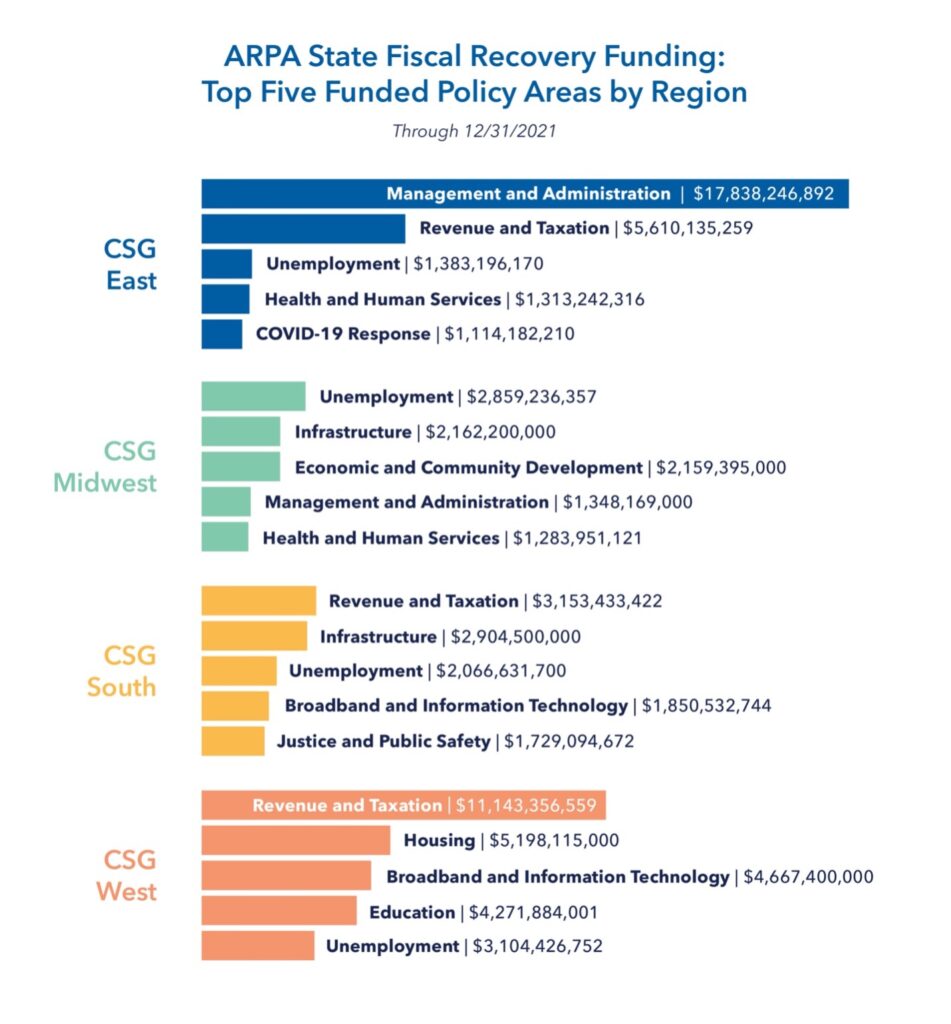
The top area for spending in CSG South ($3.2 billion) and CSG West ($11.1 billion) states was Revenue and Taxation. The top policy priority for CSG East states was Management and Administration. For CSG Midwest states, it was Unemployment. All four regions had Unemployment within their top five policy areas. Revenue and Taxation was in the top five in the East, West and South.
States lost a considerable amount of revenue during the pandemic and are using federal funds to make up for it. State governments are also acknowledging how unemployment rates were impacted by the pandemic. Millions of people lost their jobs in the early months of the pandemic. But the unemployment rate had fallen to 4.9% by October 2021.
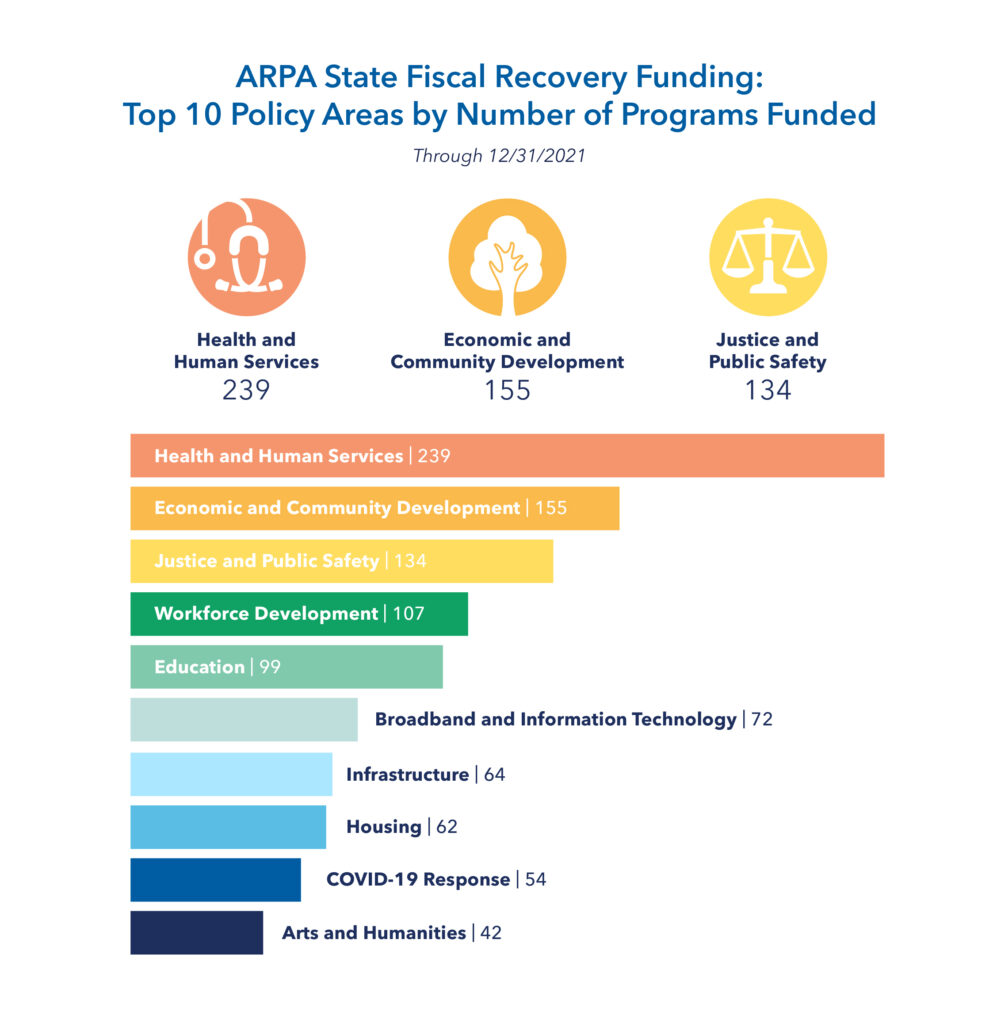
Revenue and Taxation and Management and Administration were the most invested categories and most of those funds have been used for fiscal health recovery. States also used the Coronavirus State and Local Recovery Funds to target certain areas and programs that needed additional resources, but may not have received them in “normal” years.
Among subcategories, State Fiscal Recovery Funds were invested most heavily in Health and Human Services programs (239), followed by Economic and Community Development (155) and Justice and Public Safety (134).
Of the 239 Health and Human Services programs funded, 56 involve public health. States vary in their public health needs and the programs reflect that. For example, Arkansas budgeted $10.5 million to increase hospital bed capacity while Maine allocated $102,986 to establish a program to offer free well water treatment for low-income residents. Other program areas funded in Health and Human Services include:
- Mental Health (26)
- Behavioral Health (22)
- Nutritional Stability (19)
- Long-term Care Facilities (10)
Another top program priority for states was Economic and Community Development. Economic development initiatives received the most state funds. Indiana allocated $500 million for its Regional Economic Acceleration and Development Initiative, while New Jersey is spending $15 million to develop its World Cup and Meadowlands Complex. Ensuring small businesses survived the pandemic was another high priority for states. North Carolina used $500 million to establish the Businesses Recovery Grant program to aid businesses that suffered damage due to the pandemic. Wisconsin used $46.7 million for grants to assist with costs businesses incurred for health and safety improvements. Other programs funded under Economic and Community Development include:
- Tourism (30)
- Community Development (13)
- Parks and Recreation (4)
- Diversity, Equity, and Inclusion (2)
The third most funded policy area by programs was Justice and Public Safety. The top program under this policy area was Emergency Management. Florida used $1 million to fund its Emergency Preparedness and Response Fund, while Utah used $6.9 million to update its Department of Corrections communication equipment and enhance its interoperability. Other programs funded under Justice and Public Safety include:
- Violence Prevention (10)
- Corrections (10)
- Crime Victim Services (8)
- Law Enforcement (8)
Through 2021, states allocated their ARPA funds for immediate needs. States faced revenue shortfalls and invested funding for Covid testing and other health care and health system improvements. Since states have until 2024 to allocate their APRA funds and many immediate needs for funds have been accomplished, states are going to be more flexible and creative with their ARPA funding. States will use this remaining funding to address a variety of needs.
A Guide to Resources from the CSG Overseas Voting Initiative
The goal of the Overseas Voting Initiative is to improve the voting process for citizens identified in the Uniformed and Overseas Citizens Absentee Voting Act. The Council of State Governments assists the Federal Voting Assistance Program in aligning its ongoing efforts to engage stakeholders. The program’s working group researches critical areas for improving overseas voting processes.
The Overseas Voting Initiative at CSG has developed a series of articles, reports and resources that may aid state leaders as they respond to questions and confusion related to overseas voting.
In 2019, CSG released a comprehensive report examining the sustainability of balloting solutions for military and overseas voting. The report discusses barriers to sustainable balloting technology and examines why current solutions for ensuring the successful return of ballots have not been as sustainable as intended. It also identifies obstacles that must be addressed in future research.
Overseas voters face several challenges when attempting to cast their votes. This article discusses how military and overseas voting ballots are counted. The U.S. Election Assistance Commission conducts the Elections Administration Voting Survey every two years to identify factors that influence successful vote submission. However, the survey does not sufficiently isolate factors in overseas voter experiences. In response, the working group issued a set of recommendations for streamlining and improving the survey. The working group recommended the development and implementation of a survey data standard that would identify and store transaction-level data on voter experiences — without identifying information.
- This report provides more information about the recommendations for data standardization.
- This article identifies the benefits of the data standard.
- This article highlights the progress that specific states, particularly Colorado, have made in implementing this standard.
Ballot duplication is another area of concern. Ballot duplication is the process of replacing damaged or improperly marked ballots (i.e., the voting system cannot read the ballot) with a readable ballot that preserves voter intent, according to the U.S. Election Assistance Commission.
- This article explains ballot duplication, how it is conducted and why it is important.
- CSG has developed recommendations for duplication of damaged and/or machine unreadable ballots and frequently asked questions (and answers) on ballot duplication.
- The Overseas Voting Initiative has developed recommendations on Common Access Cards, digital signature verification and responding to unreadable or damaged ballots.
CSG research has also addressed misinformation and disinformation. Access to accurate, unbiased information is crucial to preserving the integrity and security of any election. This CSG article on election safeguards provides an overview of measures that the U.S. has implemented to combat disinformation.
Finally, CSG has developed a position paper with recommendations on how to achieve a balance between security and ballot access in electronic ballot return.
CSG Healthy States National Task Force Holds Third Meeting
The 2021-22 CSG Healthy States National Task Force is a bipartisan working group of state leaders from all three branches of government. The task force is working to develop resources and recommendations to improve state civic, economic and workforce, fiscal and human health.
National Task Force members convened in July Oklahoma City, Oklahoma, for their third meeting. They discussed policy issues including civic participation, apprenticeship, telemedicine and blockchain and cryptocurrency.
Civic Health Subcommittee – Civic Participation
The Civic Health Subcommittee heard from Andrea Benjamin, a professor at the University of Oklahoma, who led a conversation on how to advance state civic health through changes to election rules, improvement in public understanding of how government works, higher participation in the political process and greater understanding among voters about the importance of their individual ballots.
After Benjamin’s presentation, the subcommittee developed a series of policy recommendations, including how to improve youth participation through programs focusing on their state’s election processes. A full recap of the Civic Health Subcommittee meeting is available here.
Economic and Workforce Subcommittee – Apprenticeships
During the Economic and Workforce Health Subcommittee meeting, Dina Klimkina — program director for education and workforce at the CSG Center of Innovation — discussed how apprenticeships can be an important policy tool for state workforce strategies. Apprenticeships fill workforce gaps and offer residents gainful career preparation alternatives to traditional four-year degree programs. State policymakers can support the expansion of apprenticeships by:
- Creating task forces with private sector partners to build apprenticeship programs and evaluate how existing programs can be expanded.
- Working with neighboring states to develop reciprocity agreements so that credentials transfer from state to state.
- Becoming model employers by launching civic sector apprenticeships.
During the subcommittee’s working session, task force members discussed how to invest in pre-apprenticeship programs for adults seeking enhanced skills and better jobs. A full recap of the Economic And Workforce Health Subcommittee meeting may be found here.
Fiscal Health Subcommittee – Blockchain and Cryptocurrency
During the Fiscal Health Subcommittee meeting, Tonya Evans, a professor of law at Penn State Dickinson Law, provided a detailed explanation of blockchain and cryptocurrency technologies. Evans urged the subcommittee to think of these technologies as digital assets and provided examples of how states are experimenting with accepting cryptocurrencies as payment for business and individual taxes.
In their working session, subcommittee members discussed the importance of public education about blockchain and cryptocurrency and explored the possibility of implementing blockchain technology in economic sectors such as agriculture and insurance. A full recap of the Fiscal Health Subcommittee meeting may be found here.
Human Health Subcommittee – Telemedicine
During the Human Health Subcommittee meeting, Kyle Zebley — vice president of public policy at the American Telemedicine Association — presented on the benefits of telehealth adoption and recent policy trends in making virtual care delivery systems effective across states. Zebley focused on the following:
- Creating interstate compacts to allow telehealth care providers to work across state lines.
- Establishing patient/provider relationships virtually.
- Prescribing controlled substances via telehealth.
- Expanding provider types.
- Expanding service ties.
- Pushing health care delivery to be modality neutral.
Subcommittee members discussed the importance of telemedicine for specific populations and needs, such as mental health care for children. The subcommittee also explored related issues such as privacy concerns and the specific cost saving potential for state programs. A full recap of the Human Health Subcommittee meeting may be found here.
Advancing State Collaboration Through Interstate Compacts
States are stronger when they collaborate to solve shared policy problems. Supporting military families, organizing the use of water resources and expanding access to telehealth services are among the key areas that transcend state borders. State coordination can be effective, but it requires a deliberate and detailed recognition of state differences and the ability to structure interstate agreements in a way that promotes mutual, long-term success.
To achieve these goals, states can leverage the power of interstate agreements. Interstate compacts are legislatively enacted agreements involving two or more states or territories or Washington D.C. Compacts are a primary tool states use to collaborate on shared policy issues. These agreements are versatile in nature and can help states:
- Settle interstate disputes.
- Respond to national priorities in cooperation with federal agencies.
- Maintain sovereignty in matters reserved to states.
- Create economies of scale to reduce administrative costs.
- Address regional issues affecting multiple states.
There are more than 200 active interstate compacts. They have been commonly used by states to coordinate and collaborate on issues such as natural resource sharing, workforce and education policies and health care delivery.
To help states develop, implement and sustain interstate compacts, CSG established The National Center for Interstate Compacts. NCIC is the only technical assistance provider on interstate compacts in the U.S. NCIC is a clearinghouse of compact information and provides educational and consulting services to states. States and stakeholder groups can engage with NCIC if they are interested in learning more about existing compacts or want to get involved with new compact efforts.
NCIC Project Example – Occupational Licensure Compacts
NCIC is working with federal and state partners and profession stakeholder groups to create new occupational licensure compacts. Occupational licensure compacts are mechanisms to help licensed professionals — particularly health care providers — work in multiple states. The compacts help states provide greater access to services, reduce administrative burdens and strengthen the protection of public health and safety.
The Department of Defense partnered with The Council of State Governments in 2021 through a cooperative agreement to fund and support the development of new interstate compacts for occupational licensure. The specific goal of this partnership is to provide greater license mobility for families of military personnel. This population moves often and faces challenges in being able to practice their profession in their new states. Current occupational licensure compacts under development include dentistry, cosmetology, teaching, massage therapy, dietetic nutrition, social work and school psychologists.
CSG is also working with stakeholder groups on the formation and administration of new compacts for audiology and speech language pathology, physician assistants/associates, occupational therapy and counseling.
For additional information on upcoming and developed compacts, visit www.compacts.csg.org or connect on Instagram @csgcompacts or Twitter @csg_compacts.
Civics 101
State leaders share perspectives on civic education for a healthy democracy.
Continue reading



